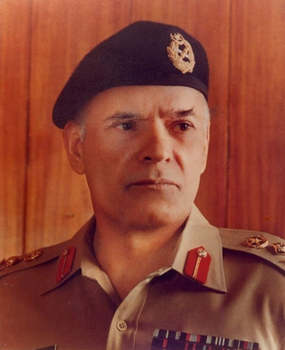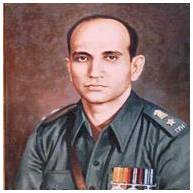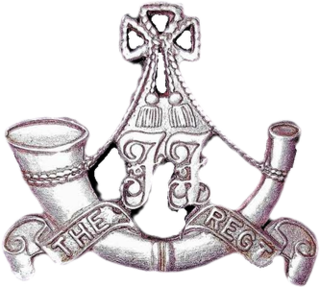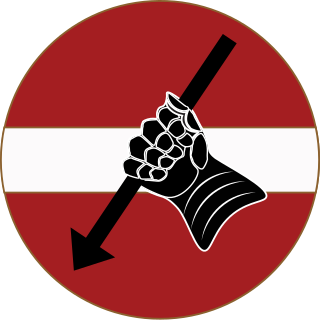
The Indo-Pakistani war of 1965, also known as the second India–Pakistan war, was an armed conflict between Pakistan and India that took place from August 1965 to September 1965. The conflict began following Pakistan's unsuccessful Operation Gibraltar, which was designed to infiltrate forces into Jammu and Kashmir to precipitate an insurgency against Indian rule. The seventeen day war caused thousands of casualties on both sides and witnessed the largest engagement of armoured vehicles and the largest tank battle since World War II. Hostilities between the two countries ended after a ceasefire was declared through UNSC Resolution 211 following a diplomatic intervention by the Soviet Union and the United States, and the subsequent issuance of the Tashkent Declaration. Much of the war was fought by the countries' land forces in Kashmir and along the border between India and Pakistan. This war saw the largest amassing of troops in Kashmir since the Partition of India in 1947, a number that was overshadowed only during the 2001–2002 military standoff between India and Pakistan. Most of the battles were fought by opposing infantry and armoured units, with substantial backing from air forces, and naval operations.
Mahmud AhmedHI(M) is a retired Pakistani three-star rank army general who served as the Director-General of the Inter-Services Intelligence from 1999 to 2001.

Operation Grand Slam was a key military operation of the Indo-Pakistani War of 1965. It refers to a plan drawn up by the Pakistan Army in May 1965, that consisted of an attack on the vital Akhnoor Bridge in Jammu and Kashmir, India. The bridge was not only the lifeline of an entire infantry division of the Indian Army, but could also be used to threaten the city of Jammu, an important logistical point for Indian forces. The operation saw initial success, but was aborted when the Indian Army opened a new front in the Pakistani province of Punjab in order to relieve pressure in Kashmir. This forced Pakistan to abandon Grand Slam and fight in Punjab, so that the operation ended in failure and stated objectives were not achieved.

Akhtar Abdur Rahman was a Pakistan Army general who served as the 5th Chairman Joint Chiefs of Staff Committee from 1987 until his death in 1988. He previously served as the 12th Director-General of Inter-Services Intelligence from 1979 to 1987. During both Indo Pak wars of 1965 and 1971, he oversaw action with his own unit 45 Field Regiment Artillery in Sundra and Hussainiwala sectors respectively.

Operation Gibraltar was the codename of a military operation planned and executed by the Pakistan Army in the territory of Jammu and Kashmir, India in August 1965. The operation's strategy was to covertly cross the Line of Control (LoC) and incite the Muslim-majority Kashmiri population's uprising against the Indian Government. The military leadership believed that a rebellion by the local Kashmiri population against Indian authorities would serve as Pakistan's casus belli against India on the international stage. Pakistan's leadership specifically chose this name to draw a parallel to the Muslim conquest of the Iberian Peninsula that was launched from Gibraltar.

The Battle of Chawinda was a major engagement between Pakistan and India during the Indo-Pakistani war of 1965 as part of the Sialkot campaign. It is well known as being one of the largest tank battles in history since the Battle of Kursk, which was fought between the Soviet Union and Nazi Germany in World War II.

Lieutenant Colonel Ardeshir Burzorji Tarapore, PVC, was an Indian military officer and posthumous recipient of India's highest military award, the Param Vir Chakra. After completing his schooling in Pune, Tarapore joined the Hyderabad Army, and was commissioned in January 1942. Initially he joined the infantry, but was later transferred to an armoured regiment, the 1st Hyderabad Imperial Service Lancers. During World War II, Tarapore saw action in the Middle Eastern theatre of the war.

Iftikhar Khan JanjuaHJ & BAR SPk SQA of the Pakistan Army is one of the most senior Pakistani officers to have been killed in action. He is known in Pakistan as the hero of the Rann of Kutch, as he was a brigadier in command of 6 Brigade, during the fighting in April 1965 prior to the Indo-Pakistani War of 1965. He was killed in a helicopter crash, in Kashmir, during the Battle of Chamb while in command of 23 Infantry Division during the Indo-Pakistan War of 1971. He is one of the only two Generals of Pakistan army to die in combat.

The Frontier Force Regiment is one of the six infantry regiments of the Pakistan Army. They are popularly known as the Piffers in reference to their military history as the PIF of the British Indian Army, or as the FF. The regiment takes its name from the historic North-West Frontier, a former province of British India and later Pakistan.
Abdul Ali Malik (1907–1993) was a three-star rank army general in the Pakistan Army and an infantry officer in the Pakistan Army from Nineteenth Battalion of Punjab Regiment who earned distinction of leading the combat infantry formations to mechanized warfare in Chawinda during the second war with India in 1965, and later commanded the I Corps during the third war with India in 1971.
Sitara-e-Jurat is the third highest military award of Pakistan. It was established in 1957 after Pakistan became a republic; however, it was instituted retrospectively back to 1947. It is awarded for gallantry or distinguished service in combat; and can be bestowed upon officers, junior commissioned officers, petty officers, warrant officers, soldiers, sailors, airmen, and equivalents in the Pakistan Army, Navy, Air Force, and various paramilitary forces under federal control, such as the Frontier Corps, the Frontier Constabulary, and the Pakistan Rangers. It may be considered to be roughly equivalent to the Military Cross and the Silver Star.
The 11th Infantry Division is an active formation of the Pakistan Army. It is currently deployed in Lahore as part of IV Corps, and is responsible for the defence of that city and the surrounding areas.

The 6th Armoured Division is a Pakistan Army armoured division currently based in Gujranwala, in Punjab Province.

The IV Corps is a field corps of the Pakistan Army, headquartered in Lahore, Punjab, Pakistan. Having established in January 1966, it is Pakistan army's of one of ten field corps formations which saw its deployment against the Indian Army in 1971.

The Battle of Chumb was a major battle between the forces of Pakistan and India during the 1971 Indo-Pakistani war. It was one of the first major engagements in the western front of the war in which the Pakistani 23rd Division captured the strategically important city of Chumb from the Indian 10th Infantry Division.
Syed Zafar Ul Hasan Naqvi is a general of the Pakistan Army.
Chaudhry Ghulam Abbas was a leading politician of Jammu and Kashmir and the President of the Muslim Conference party. After his migration to Pakistan administered Kashmir in 1947, he became the head of the Azad Kashmir (AJK) government.
Ghulam Jilani KhanHI(M) SBt was a senior general of the Pakistan Army who served as the 14th Governor of Punjab Province and 11th Defence Secretary of Pakistan in the military government of President General Zia-ul-Haq.
The Janjua or Janjhua is a Punjabi Rajput clan found predominantly in the Pothohar Plateau of Pakistani Punjab, but also in the states of Punjab and Haryana in India.










